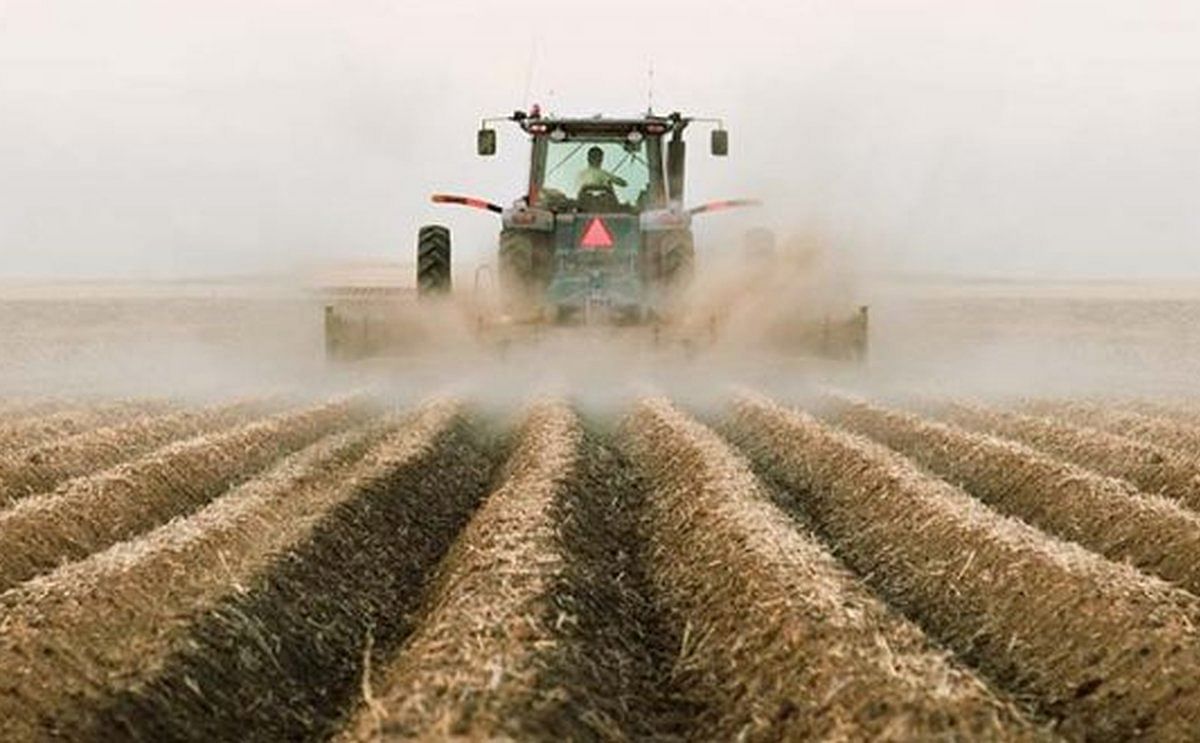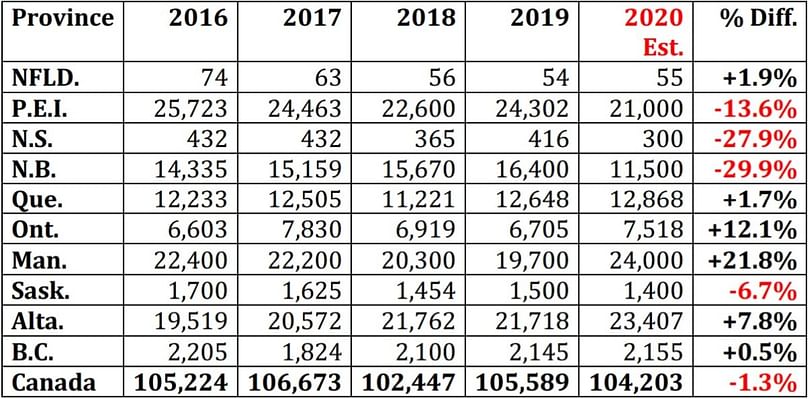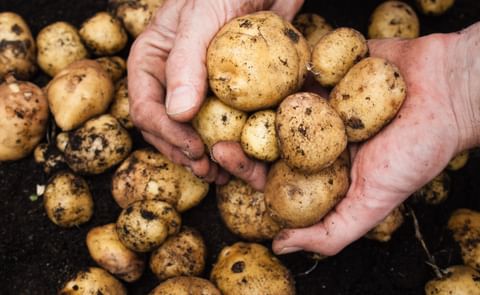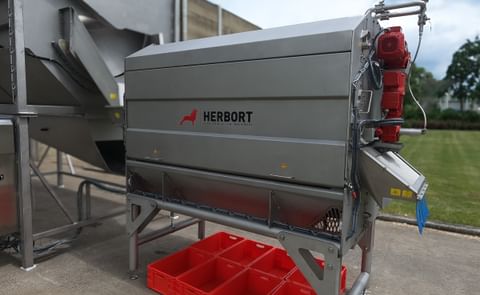Estimates of Canadian Potato Production by Statistics Canada: a slightly lower overall production, but huge regional changes
2020 Potato Production in Canada: a slight drop overall, but huge changes by province

Statistics Canada recently published estimates for the potato production in Canada in 2020. United Potato Growers of Canada provided the background information for the country as a whole and by region. The total potato harvest in 2020 was slightly lower than the production in 2019, but saw huge changes up and down for individual provinces. Prince Edward Island, traditionally the province with the highest potato production, lost this position to Manitoba and was also overtaken by Alberta.
The total potato production in Canada for the year 2020,is estimated at 104,203,000 hundredweight. This is down 1.4 million hundredweight or 1.3% below 2019.
Due to market uncertainty from COVID-19, Canada planted 5,000 fewer acres in the spring of 2020. The bigger reduction, however, came from hot dry weather conditions across the country and particularly in Eastern Canada where many growers are unable to irrigate their crops.
Canadian yields dropped 13cwt./acre from 309cwt./acre in 2019 to 296cwt./acre in 2020. There is a large regional disparity within this crop from East to West. See the following for regional details.
Statistics Canada has estimated Canadian Potato Production in 2020 to be 104,203,000 hundredweight. This is down 1.3% or 1,386,000 hundredweight below the 2019 crop. Hot, dry conditions declined yields below 2019 by 13cwt./acre to 295.9cwt./acre.
Due to better harvest conditions this fall, fewer acres had to be abandoned in comparison to the last two years. There are considerable regional differences in the crop this year as seen in the comments on individual provinces below:
Prince Edward Island:
The province was one of the region’s most severely affected by the drought. Stats Canada estimates production is down province-wide by an average of 13.6% compared to the 2019 crop. In addition, there are growers in the central part of the province who experienced reductions of 25-30%. The reduction translates to 3,300,000 hundredweight and affects all categories of production. Yields per acre dropped from 289 last year to 251.5 cwt./acre in 2020.
Nova Scotia:
Production is estimated to be down 27.9% below 2019. Hot dry weather in this eastern province reduced yields to 250cwt./acre. In addition, planted acreage was down from 1,600 acres to 1,200 acres this spring also contributing to the large reduction.
New Brunswick:
New Brunswick had the largest decrease in potato production this year at an estimated 29.9% reduction from 2019. Hot, dry weather was the cause of this 4,900,000 hundred weight shortfall below 2019. It is estimated that yields declined to 237.4cwt./acre from 310.6cwt./acre last year. All sectors of seed, table, and processing have had their supply shortened.
Quebec:
Not all data from Quebec was available at reporting time so a yield model was used to produce Quebec's harvested area, production, and yield. Estimates will be revised at a later date when available from the Institut de la Statistique du Quebec.
The model estimates Quebec's production to be up 1.7% above 2019 at 12,868,000 hundredweight. It is also estimated that yields have risen from 293cwt./acre in 2019 to 312cwt./acre in 2020.
Quebec is the one area of the country that experienced a difficult harvest this fall and reports at least 2,000 acres that were not harvested. In addition, some acreage was harvested after very cold temperatures in mid-October and will likely create higher cullage rates in those lots.
Ontario:
Stats Canada estimates Ontario’s production to be up 813,000 hundredweight or 12.1%. This would bring overall production in the province to 7,518,000 hundredweight. Stats Canada also estimates that 700 acres were not harvested in the province. Acreage in the spring had increased by 2,500 acres for both chip and fresh sectors.
Manitoba:
After a disastrous harvest last year, Manitoba reports the biggest increase in Canadian production this year, up 4,300,000 hundredweight or 21.8% above 2019. Hot, dry weather took the top off yields, moving down to 337cwt./acre from 345.6cwt./acre a year ago.
Growers, however, were pleased to be able to harvest all of their crop in record time compared to the fall of 2109 where vast acreages had to be abandoned due to wet, cold weather.
Stats Canada estimates overall production in the province to come in around 24,000,000 hundredweight. Planted acreage increased in the spring by 1,500 acres bringing the total in the country’s second-largest acreage to 71,500 acres.
Saskatchewan:
Production is expected to be down 6.7% this year with a total production of 1,400,000 hundredweight. Stats Canada estimates yields were reduced from 250 cwt./acre last year to 233cwt./acre in 2020, mostly due to a hot dry growing season. Saskatchewan acres dropped from 6,300 acres to 6,000 acres this spring.
Alberta:
Stats Canada estimates Alberta increased its production by 7.8% or 1,689,000 million hundredweight in 2020 making it the second-largest provincial increase in Canada this year. Although the growing season was a bit of a challenge, yields increased to 404cwt./acre compared to 382cwt./acre in the 2019 crop.
It also ended well with excellent harvest conditions allowing growers to pick up much more of their crop compared to a year ago. Stats Canada estimates that 1,740 acres were not harvested, likely explainable by drowned out areas in the spring.
Total production in the province is expected to reach 23,407,000 hundredweight. Growers had decreased their acreage in the spring by 1,550 acres as they reacted accordingly to processor volume reductions as a result of COVID-19 slowdowns.
British Columbia:
Stats Canada estimates production in British Columbia very close to 2019 with an increase of 0.5%. Total production is expected to come in at 2,155,000 hundredweight. An excellent growing season produced recording-breaking yields for the province at 331.5cwt./acre, up from last year’s 325cwt./acre. Good fall weather allowed all of the crop to be harvested.











